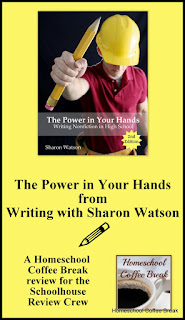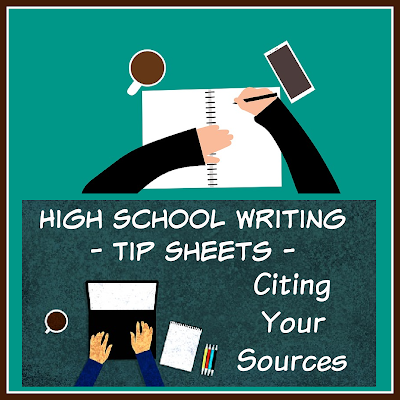This post contains affiliate links - using affiliate links from Homeschool Coffee Break helps fuel this blog.
For the past few years I have been teaching high school writing in our homeschool tutorial co-op. Having seen several groups of students through the courses, I've noticed some issues and questions coming up regularly. I hope these Tip Sheets will be helpful to my students, their parents, and perhaps to other students and parent/teachers as well.
**********
In essays and research papers at the high school level, students should be able to provided a correctly formatted Works Cited page and should be able to use in-text citations, parenthetical citations, and signal phrases in their writing. Most students have learned at least some of these skills by the time they reach high school, but it can still be confusing. Here's a quick refresher and some good sources for more detailed information.
Source Information
As you're researching and taking notes, make sure to keep a record of all the sources you use, and which info came from which source. Note taking is probably an entire tip sheet of its own, but the basic gist is that you need to know specifically where each fact, quote, or reference comes from in the source. A good practice is to keep a Source Page or Working Bibliography as you research. Write down (or type) all the bibliographic information you'll need - author, title, publisher info, and date. For web sources, keep the specific URL and record the date you accessed the information. You may want to consider printing the information as well, if practical.
Works Cited Page
The most commonly used style is Modern Language Association (MLA), and if you use Google Documents or a Word program, you will find templates that format reports and Works Cited pages in MLA style automatically. Foolproof, right?! Well, yes, but you still have to know what information to plug in, what order it appears in, and how to correctly alphabetize the list. Alphabetize by the first item that appears for each source, which is usually the author's last name. Format is hanging indent, which means the first line of each entry starts at the left margin, and the second line is indented. Do not center. Works cited should appear at the end of your essay or paper, and on a separate page. Here's what it looks like using a couple of sources I recommend:
*Note that these examples are done following the 7th edition of MLA style. The 8th edition of MLA style does not require the city of publication or the medium.
In-Text Citations
When you use MLA documentation, you will use in-text citations, meaning you incorporate the source information in the text of your paper. When you use a fact, idea, or quote from one your sources, you use a signal phrase to let the reader know you're about to share something borrowed from the source. At the end of the quote or statement, you include a parenthetical citation that will refer the reader to the complete source information on the works cited page. Examples of signal phrases include:
According to author and teacher Sharon Watson, . . .
" . . . ," writes Shona McCombes, a contributor at Scribbr.
At the end of the quotation or cited fact, you include a parenthetical citation. This is where you put the page number where the information is found in the source. If you did not include the author's name in the signal phrase, the author's last name should appear in the parentheses as well. Take a look at these examples:
In the textbook The Power in Your Hands, teacher Sharon Watson reminds students to include the credentials of anyone quoted so that readers will know the information is trustworthy (237).
Correct punctuation can be a challenge, and questions often arise about the placement of quotation marks and end marks. A parenthetical citation is part of the sentence but not the quotation. "In other words, it appears after end quotation marks but before the period" (Watson 241). Another important detail to note is that there is no comma between the author's name and the page number.
**********
Those are the basics! Using in-text citations is not difficult, but it takes a bit of practice to remember some of the rules. Check out the following online sources with lots of detailed information about citing specific types of sources.
On the Writing with Sharon Watson website, there are a number of free writing prompts and tutorials, including this one for In-text Citations for High School. You should also refer to the updated versions of a couple of lessons from the textbook I mentioned above, as the 8th edition of MLA style came out after publication of the textbook and there are a couple of changes to the format of citations. Go to the article: New Tutorials to Document Sources for an explanation and a link to download the lessons. These updated lessons from the textbook are available at no charge.
The textbook The Power In Your Hands from Writing with Sharon Watson is the one I've taught from in the co-op for several years, and I highly recommend it. You can find out more in one of my full reviews. The most recent is:


Don't miss a coffee break! Subscribe to HS Coffee Break by email
©2006-2021 Homeschool Coffee Break. All rights reserved. All text, photographs, artwork, and other content may not be reproduced or transmitted in any form without the written consent of the author. http://kympossibleblog.blogspot.com/
We are a participant in the Amazon Services LLC Associates Program, an affiliate advertising program designed to provide a means for us to earn fees by linking to Amazon.com and affiliated sites.












































0 comments:
Post a Comment
I love comments! It's like visiting over a virtual cup of coffee.